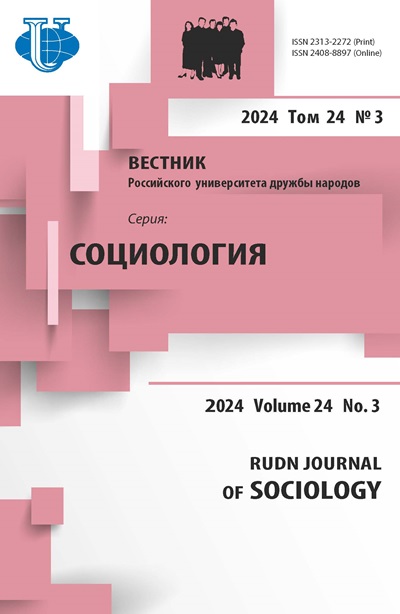INSTITUTIONS AND PRACTICES FOR INNOVATION INCENTIVES: EXPERTS’ OPINION
- Authors: Kliucharev GA1, Arsentiev MV2, Trofimova IN1
-
Affiliations:
- Institute of Sociology of FCTAS RAS
- Ileks Law Firm (Washington, USA)
- Issue: Vol 18, No 4 (2018)
- Pages: 668-679
- Section: Contemporary society: the urgent issues and prospects for development
- URL: https://journals.rudn.ru/sociology/article/view/19748
- DOI: https://doi.org/10.22363/2313-2272-2018-18-4-668-679
Cite item
Full Text
Abstract
The relevance of the study is determined by the Russia’s technological backwardness from developed and dynamically developing countries and by insufficient knowledge of mechanisms and tools to stimulate innovations in a particular social-economic environment. The authors focus on the issues of patents regulation as a key link in the transfer of innovations from science to production. The article aims at identifying features of stimulating innovation through the regulation of patent laws and practices in Russia and the United States, and possibilities of using the US experience to enhance inventive activity in Russia. The main research method was a survey of the experts representing main participants of all types of innovation activities - from design to regulation and commercialization. The theoretical base of the research consists of conceptual findings on the issues of intellectual property as a key mechanism of regulating innovative modernization. The authors also considered official documents reflecting trends in the development of patent law and practices. The intellectual property institution in today’s Russia does not ensure effectiveness of patents due to inconsistency of the state and market mechanisms for stimulating innovations. In the US, the emphasis is made on the balance between protection of property and market competition under the global technological trends. Thus, the effective innovative policy is based not on directive management and planning but on stimulating the interaction of all participants of innovation activities, which gives them the opportunity to realize their interests and opportunities both now and in the future. According to the experts, such an approach can ensure the advancement of innovations from development to commercial use, interconnection of economic sectors and, ultimately, technological modernization of the country.
About the authors
G A Kliucharev
Institute of Sociology of FCTAS RAS
Author for correspondence.
Email: kliucharev@mail.ru
-
Krzhizhanovskogo St., 24/35-5, Moscow, 117218, RussiaM V Arsentiev
Ileks Law Firm (Washington, USA)
Email: mikhail@ilexlaw.com
-
I N Trofimova
Institute of Sociology of FCTAS RAS
Email: itnmv@mail.ru
-
Krzhizhanovskogo St., 24/35-5, Moscow, 117218, RussiaReferences
- Zinov V., Kurakova N., Cherchenko O. Problema vybora indikatorov, otrazhayushchikh dolyu naukoyemkoy produktsii na globalnom rynke [The problem of selecting indicators that reflect the share of science-intensive products in the global market]. Ekonomika Nauki. 2016; 2 (In Russ.).
- Kuzmichev N. Otdam KES v khoroshie ruki [Will give SWO in good hands]. Neftegazovaya Vertikal. 2015; 7 (In Russ.).
- Godovoy otchet—2015 [Annual Report—2015]. http://www.rupto.ru/about/reports/2015/Rospatent (In Russ.).
- Rossiyskiy statisticheskiy ezhegodnik [Russian Statistical Yearbook]. Moscow: Rosstat; 2017 (In Russ.).
- Sud po intellektualnym pravam Rossiyskoy Federatsii [Intellectual Property Court of the Russian Federation]. http://ipc.arbitr.ru/ node/13545 (In Russ.).
- Burrone E. Patents at the core: the biotech business. http://www.wipo.int/sme/en/documents/ patents_biotech_fulltext.html.
- Emerging Markets and the World Patent Order. F.M. Abbott, C.M. Correa, P. Drahos (Eds.). Cheltenham: Edward Elgar Publishing; 2013.
- Freeman C. Continental, national and sub-national innovation systems — complementarity and economic growth. Research Policy. 2002. Vol. 31. No. 2.
- Global Innovation Index: The Local Dynamics of Innovation. Geneva: WIPO; 2013.
- Global Innovation Index: Winning with Global Innovation. Geneva: WIPO; 2016.
- Maskus K.E. Intellectual property rights and economic development. Case Western Reserve Journal of International Law. 2000. Vol. 32. No. 3.
- Moir H.V.J. Patent Policy and Innovation: Do Legal Rules Deliver Effective Economic? Cheltenham: Edward Elgar Publishing; 2003.
- National Innovation Systems: A Comparative Analysis. R. Nelson (Ed.). Oxford: Oxford University Press; 1993.
- National Systems of Innovation: Towards a Theory of Innovation and Interactive Learning. B.-A. Lundvall (Ed.). London: Anthem Press; 2010.
- Pressman L. et al. The Economic Contribution of University. Nonprofit Inventions in the United States: 1996—2013. https://www.bio.org/sites/default/files/files/BIO_2015_Update_of_IO_Eco_Imp.pdf.
- Sampat B.M. Patenting and US academic research in the 20th century: The world before and after Bayh-Dole. Research Policy. 2006. No. 35.
- UNESCO Institute for Statistic. Science, technology and innovation — 2015. http://data.uis.unesco.org/Index.aspx?DataSetCode=SCN_DS&lang=en.
- World Intellectual Property Report. http://www.wipo.int/edocs/pubdocs/en/wipo_pub_944_ 2015.pdf.














